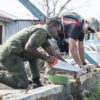By Mr A. Young
Introduction
Organisations that embrace a culture of inclusiveness maximise the opportunity to use a powerful asset: its people. This article will examine how a Just Culture founded on trust helps to develop an inclusive culture. After centuries of considering humans as something to control, modern thinking encourages us to see them as something to harness. Drawing on the modern works of Dekker’s Just Culture framework, the article will introduce the complexity of trust and associated dangers if incorrectly applied. Overall, it argues that a thorough understanding of trust is essential to creating a more inclusive culture.
Introducing Just Culture
Just Culture is an effective framework within which people engage to achieve desired outcomes. It is the type of culture where people can and will tell you the bad news even if you do not want to hear it – in NZDF language: telling the unvarnished truth.[1] The true potential of Just Culture is achieved by only a few organisations worldwide.[2] A key reason for the low number rests with the historical application of a culture that centres on Just Retribution. That approach considers humans and systems to be separate, believing that humans are something to control. Modern principles, which New Zealand adopted in 1989, understand that humans and systems co-exist within variable environments.[3] With that understanding, Sidney Dekker outlines three elements needed for effective Just Culture: Accountability, Learning, and Trust.[4]
It is beyond the scope of this article to explain the components of accountability and learning as they apply within an effective Just Culture. But it is important to understand that they rely on engagement between people to achieve the desired outcomes. Dekker explains that a truly effective Just Culture is where inclusive environments motivate people to actively contribute to improving their organisation. The opposite is an undesirable environment where people seek to limit personal liability out of fear of retribution.[5] Therefore, accountability does not focus on who did something. Instead, it asks what contributed to a success or failure – accounts are something people tell, not something to pay.[6] Learning is also forward-looking – what do we change in the coupled human-system interface to build on success or prevent recurrence of previous harm.
Suppose we are to understand how the complex interactions of humans and systems return both positive and negative outcomes. In that case, we need an inclusive environment where people can and will tell their account. Because the components of accountability and learning rely on environments where people can and will engage, the third component of trust is essential. Without trust, accountability and learning are unachievable.
The Complexity of Trust
Trust is a complex attribute that demands appreciation and understanding at all levels within an organisation. Multiple studies in the early 21st century have helped uncover its complexity. It is now accepted that the element is best broken into two areas: trust and distrust.[7] Furthermore, each area has functional and dysfunctional sub-variant behaviours; Functional Trust and Dysfunctional Trust, along with Functional Distrust and Dysfunctional Distrust. Those evolutions now result in an understanding that it is not as simple as trust is good, and distrust is bad.
Furthermore, it is flawed to believe that trust is good and the more, the better.[8] The fact is, dysfunctional behaviours of trust exist, and they can have exponential negative impacts on culture. While the need for trust may seem obvious, its complexity is not. Therefore, seizing the opportunity to continually develop a greater understanding of trust allows the NZ Army to gain a decisive edge: a more inclusive culture that enhances operational success.
Functional and Dysfunctional Behaviours
Functional trust is easy to identify within a Just Culture environment. It is typified by the existence of open and honest reporting, demonstrating a willingness to engage with a sense of purpose. In a functional trust environment, people are provided freedom of action. They will also have the necessary support when they need assistance.[9] Functional distrust is also easy to identify. It is as simple as I do not trust you just yet. It plays an important balancing role within a functional trust environment.
A simple example is when Soldier A hands over a rifle to Soldier B. Soldier B will repeat the same three-point checks conducted by Soldier A to ensure the weapon is safe. In essence, functional distrust is active engagement by people working together to achieve a common outcome of functional trust. That simple example helps understand how functional distrust is essential for an organisation to operate correctly.
Yet functional trust can easily drift towards dysfunctional trust. The rank and qualification gradients within our organisation are one way of creating these environments. Using the previous example, Soldier B may feel it unnecessary to conduct the three-point checks because Soldier A is a WO1 weapons instructor – the environment is too trusting. Another example is when we default to the most senior person in the room rather than seeking input from the subject matter expert, who could be the lowest-ranked person in the group. Dysfunctional trust is the enemy of safe, diverse, inclusive environments where people are valued for contributing.
Worse than dysfunctional trust is dysfunctional distrust. Within a Just Culture, the severest type of dysfunctional distrust exists in environments where trust is obtained through deterrence-based methods. An all-too-common example is an approach where junior personnel – an organisations future – are told you do not get to speak until you have earned it. In these environments, people comply out of fear of retribution. As a result, deterrence-based trust will hinder innovation and risk-taking.[10] Yet, as an agile and highly adaptive Army, we need people to present ideas that may involve taking a risk and innovate by seeking to act differently based on new ideas or methods.
Taking the opportunity to focus on functional trust and distrust will enhance a more inclusive culture. Importantly, multiple studies have proven that an organisation’s resilience and health rely on deliberate elements of respectful suspicion – functional distrust.[11] That is because functional distrust allows us to consider risk and invite innovation – our people can speak up and present ideas. Together, individuals can resolve disagreements to build a collective trust on how to proceed. Such actions move an organisation in a direction that inspires performance at both individual and organisation levels.[12] Without a doubt, coupling functional trust with a balanced measure of functional distrust is essential to creating an inclusive culture.
Finally, knowing how the different variants of trust influence culture are essential. Many studies have proven that trust is hard to build and easy to break.[13] Furthermore, within human-system interfaces, the smallest change at an initiating stage can return huge differences later.[14] A poignant example is how an offset gun sight was arguably the catalyst resulting in recent investigations questioning how much New Zealand could trust its Defence Force: Operation Burnham. That asymmetry provides any organisation with a good reason to reflect and consider how it achieves effective functional trust at all levels.
Conclusion
A just culture is one where people openly engage and contribute towards enhancing their organisation. Dekker’s model of Restorative Just Culture uses three components that rely on inclusive environments to create a more inclusive culture. The foundational component of that model is trust. Importantly, recent studies help us understand that an agile and innovative Army must avoid dysfunctional trust behaviours. Otherwise, unintended harm and consequences can occur.
Furthermore, exercising deliberate engagement in functional trust behaviours increases the likelihood that better decisions and adaptations to problems are used. Trust is complex, and the organisation that truly understands it will gain a decisive edge in developing a more inclusive culture, aiding operational success. That challenge is something an inclusive, agile, and highly adaptive Army can win.
Footnotes
[1] Sidney Dekker, Just Culture Short Course 1, n.d., https://www.youtube.com/watch?v=PVWjgqDANWA.
[2] Sidney Dekker, “Just Culture | The Movie,” 2018, https://www.youtube.com/watch?v=bu9yhdOegm8.
[3] Howard Zehr, The Little Book of Restorative Justice (Pennsylvania: Good Books, 2003), 2.
[4] Sidney Dekker, Just Culture: Restoring Trust and Accountability in Your Organization (CRC Press, 2018), 10.
[5] Dekker, “Just Culture | The Movie.”
[6] Sidney Dekker, The Field Guide to Understanding “Human Error”, 3rd Edition (CRC Press, 2017), 18.
[7] Stacey M Conchie and Ian J Donald, “The Functions and Development of Safety-Specific Trust and Distrust,” Safety Science 46, no. 1 (2008): 93, https://doi.org/10.1016/j.ssci.2007.03.004.
[8] Drew Rae and David Provan, “What Is the Relationship between Trust and Safety?,” 2019, https://safetyofwork.com/episodes/ep4-what-is-the-relationship-between-trust-and-safety.
[9] Paul J Zak, “THE NEUROSCIENCE OF HIGH-TRUST ORGANIZATIONS” 70, no. 1 (2018): 50.
[10] Graham Dietz and Deanne N. Den Hartog, “Measuring Trust inside Organisations,” Personnel Review 35, no. 5 (2006): 563, https://doi.org/10.1108/00483480610682299.
[11] Conchie and Donald, “The Functions and Development of Safety-Specific Trust and Distrust,” 94.
[12] Zak, “THE NEUROSCIENCE OF HIGH-TRUST ORGANIZATIONS,” 55.
[13] Stacey M Conchie and Calvin Burns, “Trust and Risk Communication in High‐Risk Organizations: A Test of Principles from Social Risk Research,” Risk Analysis 28, no. 1 (2008): 114, https://doi.org/10.1111/j.1539-6924.2008.01006.x.
[14] Sidney Dekker, “In the Systems View of Human Factors, Who Is Responsible for Success and Failure?,” in Human Factors and Ergonomics Society Europe Chapter Annual Meeting, 2009, 19.
Bibliography
Conchie, Stacey M, and Calvin Burns. “Trust and Risk Communication in High‐Risk Organisations: A Test of Principles from Social Risk Research.” Risk Analysis 28, no. 1 (2008): 141–49. https://doi.org/10.1111/j.1539-6924.2008.01006.x.
Conchie, Stacey M, and Ian J Donald. “The Functions and Development of Safety-Specific Trust and Distrust.” Safety Science 46, no. 1 (2008): 92–103. https://doi.org/10.1016/j.ssci.2007.03.004.
Dekker, Sidney. “In the Systems View of Human Factors, Who Is Responsible for Success and Failure?” In Human Factors and Ergonomics Society Europe Chapter Annual Meeting, 2009.
———. Just Culture: Restoring Trust and Accountability in Your Organisation. CRC Press, 2018.
———. “Just Culture | The Movie,” 2018. https://www.youtube.com/watch?v=bu9yhdOegm8.
———. Just Culture Short Course 1, n.d. https://www.youtube.com/watch?v=PVWjgqDANWA.
———. The Field Guide to Understanding “Human Error”, 3rd Edition. CRC Press, 2017.
Dietz, Graham, and Deanne N. Den Hartog. “Measuring Trust inside Organisations.” Personnel Review 35, no. 5 (2006): 557–88. https://doi.org/10.1108/00483480610682299.
Rae, Drew, and David Provan. “Ep.4 What Is the Relationship between Trust and Safety? | The Safety of Work,” n.d. https://safetyofwork.com/episodes/ep4-what-is-the-relationship-between-trust-and-safety.
———. “What Is the Relationship between Trust and Safety?,” 2019. https://safetyofwork.com/episodes/ep4-what-is-the-relationship-between-trust-and-safety.
Zak, Paul J. “THE NEUROSCIENCE OF HIGH-TRUST ORGANISATIONS” 70, no. 1 (2018): 45–58.
Zehr, Howard. The Little Book of Restorative Justice. Pennsylvania: Good Books, 2003.






